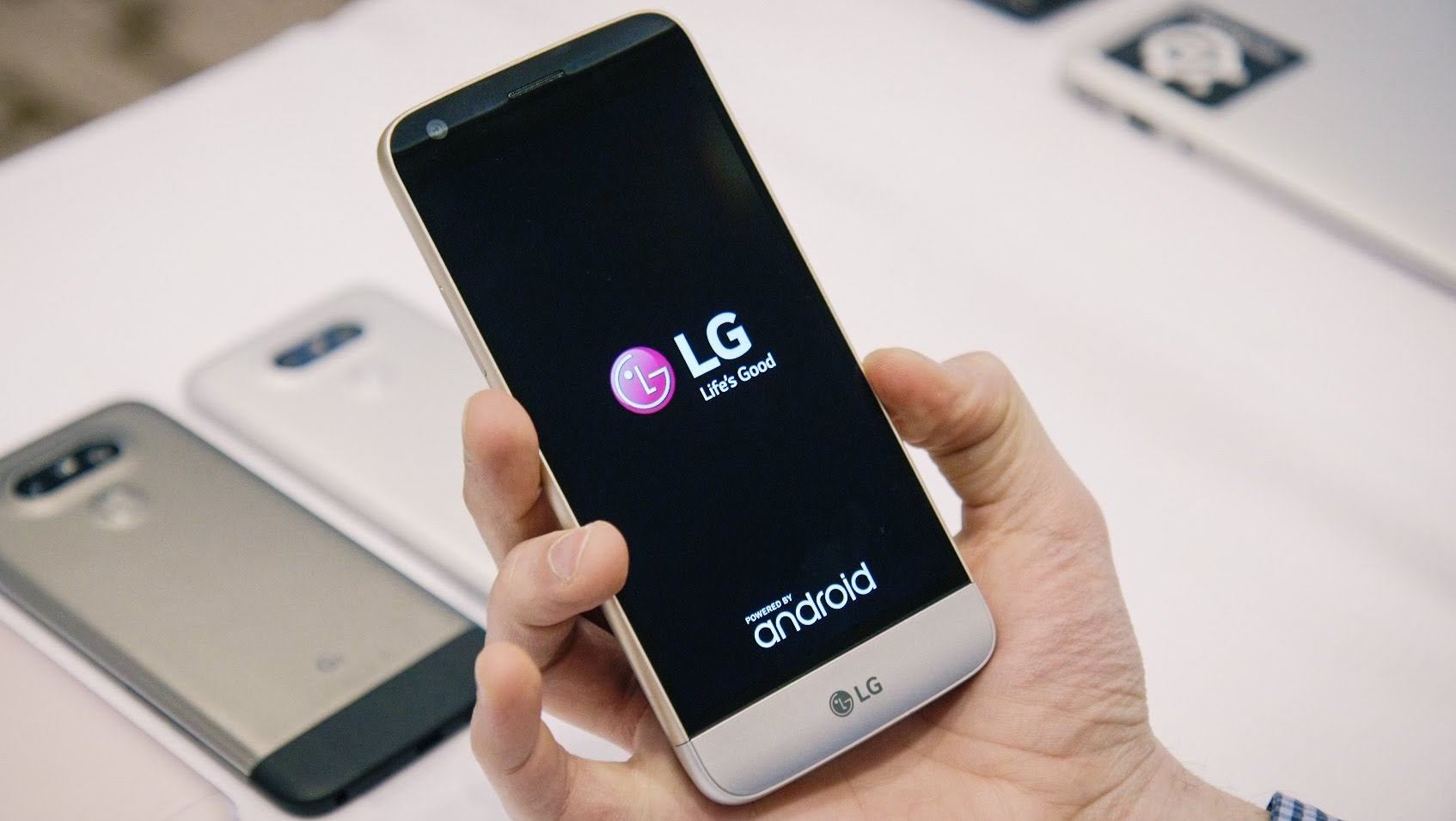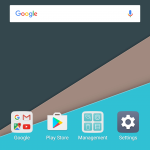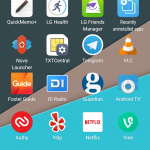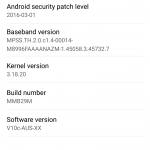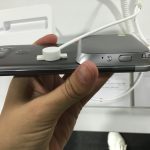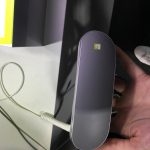[dropcap]H[/dropcap]aving attended yesterday’s launch event for LG’s G5, we couldn’t wait to get our hands on LG’s new phone and take it for a spin. As luck would have it, the day job has given me some time to accomplish this, and I’ve now had 24 hours with the new phone, as well as an assortment of LG’s Friends, including the Cam Plus module, 360 Cam, and 360 VR. We won’t see these guys on sale for another two weeks or so (from May 2), and while we hope to have a full review ready for you by that time, it’s time to take a quick peek.
My very first impressions, on seeing the G5 launch in Barcelona, was that LG was onto something here. The phone itself is striking, and yet perhaps understated. It doesn’t ooze glitz like Samsung’s Galaxy S7 range, and I think that’s a good thing — it’s modest, it doesn’t need to shout about itself. The LG G5 is equally as thin as its Korean competitor (well, 1mm thicker, but you wouldn’t know), weighs about the same, and is about the same size.
Physical aspects
Now, as then, the G5 remains an appealing phone to hold. To my mind, it’s just the right size. Though the dimensions are pretty much the same as Samsung’s Galaxy S7 (which I’ve rather enjoyed over the last month or so), it does feel a lot better in the hand; Samsung’s phone is all metal and glass, and it feels slippery, like without a case you’ll drop it and cry. LG’s phone, on the other hand, is more tactile, more grippy, and it almost wants to be in your hand.
There are those that would say that the S7 feels more premium, but really, it doesn’t. Both these phones actually feel worthy of their pricing, and though HTC haven’t confirmed their pricing yet, it too feels premium and worthwhile.
In fact, almost everything about the G5 in hand is positive; probably the only thing that I’m not used to yet is that the power button is on the back (and combined with a fingerprint sensor); I keep going to push the power button on the right side of the phone, but there’s nothing there.
LG’s opted to include USB-C instead of continuing on with MicroUSB, and it’s a welcome move. It means some new cables, but the G5 comes with a USB A to USB-C cable in the box, and you can easily get more of them if needed for the car or office.
Once you get used to where the buttons are, and remember to use the right kind of cable when charging, the LG G5 is a breeze.
There are some downsides, though
While LG G5 feels and looks great, there are some physical aspects that aren’t fantastic. The first is the heat. Granted, the Snapdragon 820 doesn’t get as hot as the 810 which it replaced, and it is more power efficient. I’ve already got no doubts about that.
However, it does like to get warm still. Twice now I’ve found the G5 quite warm to the touch, with no obvious reason for it; I’m not sure whether it could be pre-release software, whether it’s an app that’s running in the background that I’ve not noticed… but on both occasions, the G5 became quite warm, and battery power dropped rather faster than it had been.
My second concern is the battery size. 2,800 mAh isn’t too bad, but when the average is trending up, and when last year’s G4 had a bigger battery, the choice of 2,800 mAh this year is a bit of a shame.
It doesn’t matter how many times I’ve been told that someone’s hardware is more efficient, or their software is more optimised, once you put the wishy washy to one side, the number one determinant of battery longevity is battery capacity. Granted, rubbish hardware can make it significantly worse, but excellent hardware can’t improve battery life beyond a certain point.
While it appears (it’s a bit early to be sure) that LG has indeed got some great hardware, and done some clever things with software optimisation, the fact remains that a 2,800 mAh battery will only last so long — and by so long, I mean maybe ten hours or so.
It’s early to make a prediction, but I’ll do it anyway; the LG G5 will not be an all-day phone under normal use. I hope that I’m proven wrong; I hope that in the next few days I see the G5 battery settle down and last a good twelve hours or so. Given the other Koreans engineered a phone with substantially the same internals that can last from off-charge at 6am until about 10pm at night, the G5 should be able to do this.
We’ll see if it can deliver.
What’s the software like?
In a nutshell, LG’s software is great, with just one reservation. The decision to eschew the traditional Android launcher setup, with a desktop and separate app drawer, is a bit weird. It’s a bit iPhone, if we’re honest, and I’m not sure that it really works terribly well. I’m sure there are those who think this is fine, and it’s just something to get used to (following a bit of the ‘be together, not the same’ mantra), but if you ask me, there are some things about Android that work really well, and having an app drawer is one of them.
This isn’t to say LG’s launcher is bad; it isn’t. In fact, it’s better than it was last year (the G4 launcher was a bit over the top with fancy widgets that, really, no one needed), and even without that comparison point, it’s quite good anyway.
LG’s motif is indeed different to that used by Samsung, HTC and Sony, and while it’s not any better or worse, I quite like it. I dislike stock launchers, usually, because I think 3rd party developers have actually lifted the standard quite a lot, but as stock goes, LG’s software is quite usable, it’s fast, transitions are rapid, and swapping between apps feels ever so slightly quicker than on Samsung’s S7 range.
LG has its own take on certain apps, including phone, contacts, and more, and they’re quite acceptable. I don’t think they’re any better or worse than what others are doing.
There are a couple of things that others have left out this year, which makes the G5 a better value proposition for users who value those features. G5 still has an FM radio on board, and it retains the IR emitter for use as a universal remote control .. something Samsung has done away with.
How’s the camera?
While it’s a bit early to be conclusive, I’ll say this: the G5 camera is pretty great in most circumstances. I want more time to experiment with low light, and to try out the full range of environments we usually try, but for macro photography and beautiful landscapes, I think the G5 nails it.
Some of these photos are just brilliant; the close-up photo of the chain links, the wide-angle shot of the park.. these are just immersive, wonderful photos that show off detail, colour and light The G5 doesn’t like brightly lit backgrounds with darker subjects, but not many cameras do. You can compensate for this with manual controls, but using the automatic settings gets you 95% of the way there for far less effort.
This is where we delve into some of the G5’s Friends; in particular, the 360 Camera. I can see so much potential in this, and a lot of fun to be had. To show off what it’s capable of, I’ve got a couple of 360º photos for you to check out, and a 360º YouTube video as well.
There are a couple of caveats here, and while I’ll go into these more later, here’s a quick heads up:
- Video recording appears to be limited to 20 minutes at a time. If you want to record more, you might not be able to without making multiple recordings.
- Battery life on the 360 Camera is good, but it won’t last forever. You can, however, plug in an external power pack.
- Capture and stitching is fast, and it’s all done on the camera. You don’t need to have your phone turned on, connected, or even with you in order to use it. It’s truly stand-alone.
- Transfer / preview speeds on the G5 are good, though video transfers can take a little while. Anyone who’s used a GoPro and wireless transfers will know exactly what this is like.
- Fortunately, the software for managing this process is really, really easy and intuitive. I didn’t even have to open the manual.
- Sharing options are limited … for now. You can share 360º photos on Google Photos, but you can’t really share 360º videos there. They play back, but they’re not interactive or rendered properly; you can’t explore them like a 360º video on YouTube.
- Speaking of YouTube, you can share the 360º videos there … but seemingly not from your phone. If you want them to render properly in YouTube so your viewers can pan/zoom around your video, you have to upload them via a Desktop and use a meta-data adding app to make it work properly. It’s easy enough once you know how, but it should be able to be done right from the phone.
- Embedding photos in other web pages to show them off isn’t exactly easy. You can do it, with the use of some software Google makes available for free, but it’s not as intuitive as sharing photos on Facebook or Twitter.
Here’s two sample 360º photos you can check out, and a video below. Firstly, near the playground:
Secondly, in the middle of the field:
Bear in mind that I put very little planning or effort into either photo. The lighting isn’t perfect (you can see one side, or 180º, of the photos is a bit brighter than the other half), and there is a bit of blur here and there. However, this shows what you can do by simply grabbing the 360 Cam, and taking a photo. It’s absolutely effortless, and a bit of planning goes a long way towards making a truly memorable shot.
You can share it — as we have done — using VR Viewer on your own website, or embed it in a Google Photos album and share that wherever you like.
The video sample is — again — not especially well planned; I simply turned on the video recorder, walked around it, and did a bit of a crap voiceover. The remarkable thing is that the whole process of capturing the video (about 30 seconds worth), adding the desktop metadata (about a minute) and uploading it to YouTube (about 30 seconds over LTE) took less than five minutes. You, too, can create 360º video content as easy as this, and share it just as fast.
The possibilities here are truly a bit unknown, because this is all so new to most of us. However, you could do so much with this — hold it out the window of a car, take it on a roller-coaster, throw it through the air like a ball (don’t do that), or take it to a public performance and record not only what’s happening on the stage, but the reactions of the crowd as well.
It’s so small, and so cool, that LG will be prying this from my cold dead hands. Mark my words.
Some of the other modules simply aren’t quite so cool
The Cam Plus attachment is nice; it operates essentially as a ‘battery grip’ (most who dabble in DSLRs will know what that means), giving you an extra shape to hold onto when taking photos, and a bit of extra power as well. However, it doesn’t work the way you’d think, increasing the overall battery capacity of the G5. Instead, it offers a bit of extra power when the Cam Plus is being used … but when it’s not in use, the battery doesn’t so anything for your phone. It would’ve been much more useful if it could somehow supplement the 2,800 mAh battery and make it into an (effectively) 4,000 mAh battery instead. I guess it kind of does that, but not in the way we’d hoped.
The Cam Plus attachment does, though, make taking decent photographs a bit easier; it’s easier to hold than just the thin slab of the phone, and the external camera keys (instead of poking at the touch screen) are easier to use. Photography aficionados will want this.
LG’s 360 VR won’t be released in Australia from what we understand, and while that’s a shame, we can understand why; I just don’t think it’s ready for the market just yet. Google’s Cardboard is easier to set up and use, and Samsung’s Gear VR is more powerful (and perhaps a little easier to set up, focusing especially). LG hasn’t got a lot of content you can enjoy on the 360 VR just yet; though it’s supposed to be compatible with Cardboard apps, I haven’t quite worked out how to use them yet.
In any event, the 360 VR is a bit uncomfortable — the arms dig in a little, there’s a bit of light bleed because they’re not as snug fitting as other experiences (HTC’s Vive or Samsung’s Gear VR), but they still show promise. I think we might see a second generation of this product do an awful lot better. As a preview of what’s to come, though, I look forward to a bit more time to experiment here.
We don’t yet have a Rolling Bot or a Bang and Olufsen HiFi DAC module, but we’re working on getting them and we’ll look at them separately when they arrive.
Initial … conclusions?
The G5 deserves a lot more than 24 hours before reaching conclusions, though I am convinced some ‘reviewers’ haven’t spent much more time than this with the G5 before slamming it.
LG’s modularity is a bit of an experiment, if we’re honest. Removable batteries are cool, and I praise LG for retaining that option — road warriors will love this feature. The LG Friends concept is a bit hit and miss. The 360 Camera is a hit, the 360 VR is probably a miss, and the Cam Plus module lies somewhere in between; it could’ve been better, but it isn’t bad.
Whether the accessories are successful or take off, though, really doesn’t matter much. The G5 by itself has all the hallmarks of a great phone. A strong camera. Fast software. Battery life that isn’t terrible (though, it certainly could be a bit better… time will tell). A great in-hand feel, and something that looks good and will be recognised as a premium product.
Would I go and buy one, with only the past 24 hours as my reference? It’s a bit too early to tell. I demand a lot in terms of battery life and I’m worried the G5 may not be able to deliver, but on the other measures, I’m all but convinced. Keep an eye out for my full review in a week or so for the final conclusion.
In the meantime, it’s off to play with the 360 Camera a bit more … and to find a phone charger for the now-flat G5.
LG’s G5 will retail for $1,099, and the LG 360 Cam will retail for $399, both available from May 2nd.
What questions would you like answered in our review? I’ll answer what I can here, and investigate further for the review as needed.

